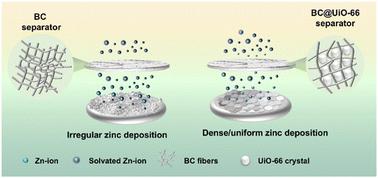创新的细菌纤维素和UiO-66复合材料,具有卓越的锌离子电池隔膜性能†
IF 9.2
1区 化学
Q1 CHEMISTRY, MULTIDISCIPLINARY
引用次数: 0
摘要
水性锌离子电池(AZIBs)面临着锌枝晶形成和循环稳定性差等挑战。在这里,我们报告了一种室温原位生长策略,用于制造用于azib的细菌纤维素-金属有机框架复合材料分离器(BC@UiO-66)。在这种方法中,uuo -66(一种基于zr的MOF)在BC纳米纤维上均匀生长,形成95 μm厚的膜,具有分层孔隙度和丰富的路易斯酸位点。所得BC@UiO-66分离器有利于Zn2+通过相互连接的纳米通道扩散,促进均匀的Zn沉积,从而抑制枝晶生长。使用BC@UiO-66的Zn||Zn对称电池在1ma cm - 2下稳定工作2400小时以上,而Zn||MnO2全电池在1a g - 1下循环1000次后保持162.98 mAh g - 1,库仑效率为100%。这些结果证明了mof -纤维素复合分离器在延长AZIB循环寿命方面的有效性。本文章由计算机程序翻译,如有差异,请以英文原文为准。

Innovative bacterial cellulose and UiO-66 composites for superior zinc ion battery separator performance†
Aqueous zinc-ion batteries (AZIBs) face challenges such as Zn dendrite formation and poor cycle stability. Here, we report an ambient-temperature in situ growth strategy to fabricate a bacterial cellulose-metal organic framework composite separator (BC@UiO-66) for AZIBs. In this approach, UiO-66 (a Zr-based MOF) grows uniformly on BC nanofibers, forming a 95 μm-thick film with hierarchical porosity and abundant Lewis acid sites. The resulting BC@UiO-66 separator facilitates Zn2+ diffusion through interconnected nanochannels and promotes uniform Zn deposition, thereby suppressing dendrite growth. A Zn||Zn symmetric cell using BC@UiO-66 operates stably for over 2400 h at 1 mA cm−2 and a Zn||MnO2 full cell retains 162.98 mAh g−1 after 1000 cycles at 1 A g−1 with ∼100% coulombic efficiency. These results demonstrate the efficacy of MOF-cellulose composite separators in extending AZIB cycle life.
求助全文
通过发布文献求助,成功后即可免费获取论文全文。
去求助
来源期刊

Green Chemistry
化学-化学综合
CiteScore
16.10
自引率
7.10%
发文量
677
审稿时长
1.4 months
期刊介绍:
Green Chemistry is a journal that provides a unique forum for the publication of innovative research on the development of alternative green and sustainable technologies. The scope of Green Chemistry is based on the definition proposed by Anastas and Warner (Green Chemistry: Theory and Practice, P T Anastas and J C Warner, Oxford University Press, Oxford, 1998), which defines green chemistry as the utilisation of a set of principles that reduces or eliminates the use or generation of hazardous substances in the design, manufacture and application of chemical products. Green Chemistry aims to reduce the environmental impact of the chemical enterprise by developing a technology base that is inherently non-toxic to living things and the environment. The journal welcomes submissions on all aspects of research relating to this endeavor and publishes original and significant cutting-edge research that is likely to be of wide general appeal. For a work to be published, it must present a significant advance in green chemistry, including a comparison with existing methods and a demonstration of advantages over those methods.
 求助内容:
求助内容: 应助结果提醒方式:
应助结果提醒方式:


